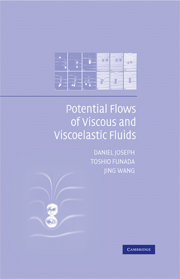Book contents
- Frontmatter
- Contents
- Preface
- List of Abbreviations
- 1 Introduction
- 2 Historical notes
- 3 Boundary conditions for viscous fluids
- 4 Helmholtz decomposition coupling rotational to irrotational flow
- 5 Harmonic functions that give rise to vorticity
- 6 Radial motions of a spherical gas bubble in a viscous liquid
- 7 Rise velocity of a spherical cap bubble
- 8 Ellipsoidal model of the rise of a Taylor bubble in a round tube
- 9 Rayleigh–Taylor instability of viscous fluids
- 10 The force on a cylinder near a wall in viscous potential flows
- 11 Kelvin–Helmholtz instability
- 12 Energy equation for irrotational theories of gas–liquid flow: viscous potential flow, viscous potential flow with pressure correction, and dissipation method
- 13 Rising bubbles
- 14 Purely irrotational theories of the effect of viscosity on the decay of waves
- 15 Irrotational Faraday waves on a viscous fluid
- 16 Stability of a liquid jet into incompressible gases and liquids
- 17 Stress-induced cavitation
- 18 Viscous effects of the irrotational flow outside boundary layers on rigid solids
- 19 Irrotational flows that satisfy the compressible Navier–Stokes equations
- 20 Irrotational flows of viscoelastic fluids
- 21 Purely irrotational theories of stability of viscoelastic fluids
- 22 Numerical methods for irrotational flows of viscous fluid
- Appendix A Equations of motion and strain rates for rotational and irrotational flow in Cartesian, cylindrical, and spherical coordinates
- Appendix B List of frequently used symbols and concepts
- References
- Index
14 - Purely irrotational theories of the effect of viscosity on the decay of waves
Published online by Cambridge University Press: 09 October 2009
- Frontmatter
- Contents
- Preface
- List of Abbreviations
- 1 Introduction
- 2 Historical notes
- 3 Boundary conditions for viscous fluids
- 4 Helmholtz decomposition coupling rotational to irrotational flow
- 5 Harmonic functions that give rise to vorticity
- 6 Radial motions of a spherical gas bubble in a viscous liquid
- 7 Rise velocity of a spherical cap bubble
- 8 Ellipsoidal model of the rise of a Taylor bubble in a round tube
- 9 Rayleigh–Taylor instability of viscous fluids
- 10 The force on a cylinder near a wall in viscous potential flows
- 11 Kelvin–Helmholtz instability
- 12 Energy equation for irrotational theories of gas–liquid flow: viscous potential flow, viscous potential flow with pressure correction, and dissipation method
- 13 Rising bubbles
- 14 Purely irrotational theories of the effect of viscosity on the decay of waves
- 15 Irrotational Faraday waves on a viscous fluid
- 16 Stability of a liquid jet into incompressible gases and liquids
- 17 Stress-induced cavitation
- 18 Viscous effects of the irrotational flow outside boundary layers on rigid solids
- 19 Irrotational flows that satisfy the compressible Navier–Stokes equations
- 20 Irrotational flows of viscoelastic fluids
- 21 Purely irrotational theories of stability of viscoelastic fluids
- 22 Numerical methods for irrotational flows of viscous fluid
- Appendix A Equations of motion and strain rates for rotational and irrotational flow in Cartesian, cylindrical, and spherical coordinates
- Appendix B List of frequently used symbols and concepts
- References
- Index
Summary
Decay of free-gravity waves
It is generally believed that the major effects of viscosity are associated with vorticity. This belief is not always well founded; major effects of viscosity can be obtained from purely irrotational analysis of flows of viscous fluids. Here we illustrate this point by comparing irrotational solutions with Lamb's (1932) exact solution of the problem of the decay of free-gravity waves. Excellent agreements, even in fluids 107 more viscous than water, are achieved for the decay rates n(k) for all wavenumbers k, excluding a small interval around a critical value kc, where progressive waves change to monotonic decay.
Introduction
Lamb (1932, §348, §349) performed an analysis of the effect of viscosity on free-gravity waves. He computed the decay rate by a DM, using the irrotational flow only. He also constructed an ES for this problem, which satisfies both the normal and shear stress conditions at the interface.
Joseph and Wang (2004) studied Lamb's problem by using the theory of VPF and obtained a dispersion relation that gives rise to both the decay rate and the wave velocity. They also used VCVPF to obtain another dispersion relation. Because VCVPF is an irrotational theory, the shear stress cannot be made to vanish. However, the shear stress in the energy balance can be eliminated in the mean by the selection of an irrotational pressure that depends on viscosity.
- Type
- Chapter
- Information
- Potential Flows of Viscous and Viscoelastic Liquids , pp. 159 - 196Publisher: Cambridge University PressPrint publication year: 2007

